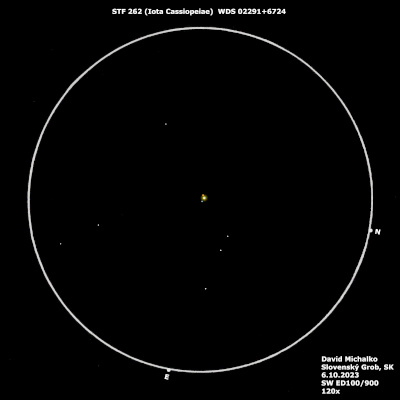Cas
☀4.63/6.92mag
Ø
2''

STF 262 (Iota Cassiopeiae) is certainly a triple system, but possibly even a quintuple system, located at a distance of 133 light-years (some sources mention 146 light-years) from the Sun. The primary component A forms a very close astrometric binary consisting of components Aa and Ab. Aa is an atypical white star of spectral class A5p with a mass of 1.98 times that of the Sun, while Ab is a yellow main-sequence star of spectral class G6V with a mass of 0.90 times that of the Sun. Components Aa and Ab orbit around their common center of mass with a period of 47 years, and they were visually resolved for the first time in 2001. The companion B is a yellow-white main-sequence star of spectral class F5V with a mass of 1.2 times that of the Sun. The orbital period of components A and B is 2400 years (some sources mention only 620 years). The second companion C is a spectroscopic binary consisting of components Ca a yellow main-sequence star of spectral class G7V with a mass of 0.8 times that of the Sun, and Cb a red dwarf of spectral class M2V with a mass of 0.6 times that of the Sun. It is uncertain whether component C is only an optical or also a physical member of the system. There is a certain probability that it is gravitationally linked to component B making STF 262 a potentially quintuple system.
100mm - STF 262 is easily observable even with small telescopes. At 120x magnification, I distinctly resolved individual components. I observed the primary component as white with a hint of yellow, component B as a subtly orange hue, and C as gray with a slight hint of blue. In the past, I successfully observed this system with a 72mm refractor.